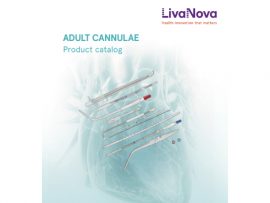Abstract Introduction Cardiac surgery in infants often triggers a severe inflammatory response. The role of biomarkers in predicting clinical outcomes in this group of patients has been debated in the..
Lee masAbstract Background: Population pharmacokinetics (PK) models could provide specific references for the formulation of personal drug delivery protocols, however, there is no population PK study of tranexamic acid (TXA) have been..
Lee masAbstract Introduction: Indexed oxygen delivery (DO₂i) is a critical parameter in cardiopulmonary bypass (CPB) management. Traditional goal-directed perfusion (GDP) protocols use fixed DO₂i thresholds, typically derived from normothermic conditions. However,..
Lee masAbstract Purpose Clinicians presume a relationship between the management of blood pressure during cardiac surgery and postoperative morbidity and mortality. With limited evidence to inform practice, we surveyed Canadian cardiac..
Lee masAbstract Acute kidney injury (AKI) is a frequent and severe problem following heart surgery, particularly in procedures involving cardiopulmonary bypass (CPB). This research investigates the Randomized Controlled Trial (RCT) on..
Lee masAbstract Background Delirium is a common neurological complication after cardiac surgery. The purpose of the present study was to analyze the association between hemodynamic fluctuations during cardiopulmonary bypass (CPB) and..
Lee masAbstract Introduction Imbalance in the redox equilibrium is common in any type of aggression. Cardiopulmonary bypass (CPB) initiation induces metabolic perturbations, and reliable biological monitoring tools for this condition are..
Lee masAbstract Background Acute kidney injury (AKI) usually occurs after cardiopulmonary bypass (CPB) and threatens life without timely intervention. Early assessment and prevention are critical for saving AKI patients. However, numerical..
Lee masAbstract OBJECTIVES Peripheral cannula selection in minimally invasive cardiac surgery (MICS) is crucial, as venous drainage limitations during cardiopulmonary bypass (CPB) can impair end-organ perfusion and overall outcomes. This study..
Lee masAbstract Objective Cardiac arrest happens in 0.7%-5.2% patients after cardiovascular surgery, and cases with asystole or severe bradycardia need timely temporary pacing. However, routine temporary pacing wire insertion in cardiopulmonary..
Lee masAbstract Purpose Neonates undergoing cardiopulmonary bypass (CPB) are at a high risk of a systemic inflammatory response leading to cardiac, respiratory, and renal dysfunction due to their small body size..
Lee masAbstract Background: Cardiopulmonary bypass (CPB) and extracorporeal membrane oxygenation (ECMO) are widely used. Previous methods to reduce inflammation have shown inconsistent results. We developed a cytokine adsorption column using polymethyl methacrylate..
Lee masAbstract Background Cardiac surgery is associated with increased risk of major adverse outcomes. Venous to arterial carbon dioxide tension gap (Pv-aCO2 gap) showed significant prognostic value of non-cardiac surgery, while their..
Lee masAbstract Introduction Cardiopulmonary bypass (CPB) is essential for cardiac surgery but poses risks, including gaseous micro emboli (GME). While the incidence of stroke—a common clinical consequence of embolism—ranges from 1-5%..
Lee masAbstract Background Acute kidney injury (AKI) is common in children with congenital heart disease following open-heart surgery with cardiopulmonary bypass (CPB). Early AKI detection in critically ill children requires clinician..
Lee masAbstract The paper published in this issue of the ICVTS by Green and colleagues [] from the University of Hull in the UK addresses an often underestimated yet increasingly recognized issue in..
Lee masAbstract Background Cardiac surgery is associated with increased risk of major adverse outcomes. Venous to arterial carbon dioxide tension gap (Pv-aCO2 gap) showed significant prognostic value of non-cardiac surgery, while their..
Lee masAbstract Objective To compare the application and outcomes of femoral versus axillary arterial cannulation in adult patients undergoing surgery for type A aortic dissection. Methods We conducted a retrospective review..
Lee masAbstract Introduction This retrospective study investigated the relationship between differing thresholds of Conventional Ultrafiltration (CUF) and postoperative hemoglobin (HGB) in cardiac surgery cases involving cardiopulmonary bypass. Methods The study utilized..
Lee masAbstract Background and Aims Innovative advancements in cardiopulmonary bypass (CPB) configurations, such as surface coating, blood filtration, and miniaturization, aim to reduce gaseous microemboli (GME) that contribute to embolic organ..
Lee masAbstract OBJECTIVES Peripheral cannula selection in minimally invasive cardiac surgery (MICS) is crucial, as venous drainage limitations during cardiopulmonary bypass (CPB) can impair end-organ perfusion and overall outcomes. This study..
Lee masAbstract Vasoplegic syndrome (VS) is a common and potentially life-threatening complication of cardiac surgery with cardiopulmonary bypass (CPB). It presents a significant haemodynamic challenge that is often difficult to manage..
Lee masAbstract Objective Postoperative pneumonia (POP) frequently complicates cardiac surgery that involves cardiopulmonary bypass (CPB). This study aimed to assess the diagnostic utility of procalcitonin (PCT) for identifying pneumonia after CPB-assisted..
Lee masAbstract The paper published in this issue of the ICVTS by Green and colleagues [] from the University of Hull in the UK addresses an often underestimated yet increasingly recognized issue in..
Lee masAbstract A venous reservoir (VR) is crucial for safe blood volume regulation during cardiopulmonary bypass (CPB) procedures. Currently, blood volume measurement in VRs relies heavily on visual inspection, which limits..
Lee masAbstract Abstract Objective To investigate cerebral autoregulation impairment during neonatal cardiac surgery. Design A retrospective observational study. Setting Single-center, university teaching children’s hospital. Participants Neonates undergoing surgery for critical congenital..
Lee masAbstract Background Postoperative delirium (POD) remains a significant complication following cardiopulmonary bypass (CPB) surgery, particularly in middle-aged patients who constitute the majority of this surgical population. While intranasal insulin (INI)..
Lee masAbstract IMPORTANCE: Cardiopulmonary bypass (CPB) surgery is associated with changes in the intestinal microbiome. Metabolism of tryptophan into the indole pathway is entirely facilitated by the intestinal microbiome, and indole..
Lee masAbstract Background: Plastic-containing medical devices are commonly used in critical care units and other patient care settings. Patients are often exposed to xenobiotic agents that are leached out from plastic-containing..
Lee masAbstract Background The nadir oxygen delivery index (DO2i) during cardiopulmonary bypass (CPB) is reportedly associated with acute kidney injury (AKI) in patients undergoing cardiac surgery. However, there are few reports..
Lee mas

















